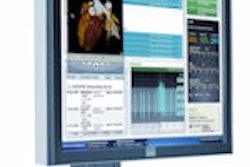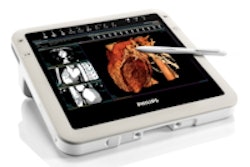CHICAGO - The cancer Biomedical Informatics Grid (caBIG) is an informatics network established in 2004 that enables clinicians, researchers, and vendors in the cancer community to share data. Its objective is to accelerate the discovery of new diagnostics and therapeutics to improve patient outcomes.
Diagnostic images are retained in the National Cancer Imaging Archive (NCIA), and the challenge of their utilization is being addressed by open source software in development by the caBIG Imaging Workspace.
The caBIG Imaging Workspace is a national, multidisciplinary expert advisory board for the identification and prioritization of imaging informatics issues and projects. In only three years, this National Cancer Institute-funded project is by far the biggest and most productive effort in imaging informatics today, according to Dr. Eliot Siegel, vice chairman of the department of diagnostic radiology at the University of Maryland School of Medicine in Baltimore.
Siegel presented RSNA 2008 attendees with a concise update of the activities being undertaken.
The NCIA was established in April 2005 to make reference image databases and specific databases such as the lung imaging consortium available to researchers. It is a searchable repository of in vivo cancer images to be used in the development and validation of analytic software tools that support lesion detection and classification, accelerated diagnostic imaging decision, and quantitative image assessment of drug response. The archive has now expanded to include a wide variety of databases being used to support clinical trials, academic research and teaching, and other reader studies, Siegel reported.
The NCIA has been adopted in the U.K. by the National Cancer Research Institute, an organization comparable to the U.S. National Cancer Institute. Collaborative activities are also being undertaken with the American College of Radiology Imaging Network.
The NCIA initiative is both a repository archive and a free software suite that provides a means of capturing, storing, and showing medical images for use with the database archive. The NCIA facilitates secure sharing of images, using a single point of entry.
The software suite enables diagnostic images to be added to the database by any registered user and facilitates efficient retrieval. Database searches may be conducted by specifying features of images based on human or machine analysis. For example, searches can be conducted using combinations of criteria that include modality, anatomical site, use of contrast, and image slice thickness.
Users have the ability to annotate and mark up images from their searches, and these notations are added permanently to be shared with others.
Major current projects include the following:
The development of an eXtensible imaging platform. This is a free and open source platform that facilitates the sharing of images and other patient data, as well as image display format, image processing applications, and the analysis algorithms themselves.
"Grid computing has received surprisingly little attention in diagnostic imaging despite its tremendous potential to promote interoperability, improve security, and support more efficient sharing of image data and software algorithms," Siegel noted. "Middleware software, such as GridCAD and Virtual PACS, is used to create interoperability between DICOM devices and the caGRID, which uses a service-oriented architecture." Virtual PACS translates a query from a user to efficiently interact with data sources and identify relevant images. By using a common data representation, heterogeneous data sources are wrapped with a common interface.
Development of an annotations and imaging markup tool is the first project of its kind to propose and create a "standard" means of adding information to an image in a clinical environment, enabling image content to be easily and automatically searched. "The current environment is chaotic because vendors use different methodologies. The advantage is to capture data once and enable this notated data to be used many times by others," Siegel said. Examples of notations include descriptions of a tumor that define the type of cancer and its size, margins, and spatial relationships.
Ontologies provide semantic markup of data sources that interrelate data to create a virtual data warehouse. A DICOM ontology under development will provide single common reference information for all caBIG projects that need to refer to imaging.
The Image Query Formulation Tool will provide an interface that automates the creation of ontology-based queries to image resources, with delivery of a platform and Image Query Tool (IQ Tool). A Query Formulation Engine will translate user queries that are formulated using the IQ Tool user interface into an ontology-based query graph.
Algorithm validation tools are being developed to provide a set of tools capable of generating measurements using validated and consistent methods for detecting change. These associate information, including clinical outcome data, that would be helpful in assessing the performance of image-based change assessment tools. Siegel cited the ability to measure recent tumor volume changes as an example.
Clinical Trial Processor software in development is a standalone application for processing clinical trial data. It works with a MIRC field center for data acquisition and has the ability to support multiple trials simultaneously. It is designed to get through firewalls without opening ports to protected networks. It also has new anonymizing capabilities.
The addition of pathology images to the archive may necessitate the creation of a different archive of images and a different visualization engine. These would be transparent to the user, and this is a topic for discussion in 2009.
When Siegel was asked if he thought the new presidential administration would maintain the level of funding for the project, he was optimistically hopeful. "Imaging has become one of the highest priorities of caBIG, and the National Cancer Institute is very supportive," he said. "With this level of interest, I hope that the funding level will be maintained."
The current version of NCIA software is being demonstrated in an educational exhibit at the Lakeside Learning Center throughout the RSNA meeting.
By Cynthia Keen
AuntMinnie.com staff writer
November 30, 2008
Related Reading
Imaging informatics can contribute much to clinical research, June 11, 2007
NCI's caBIG imaging group to hold first meeting, December 12, 2005
Copyright © 2008 AuntMinnie.com



















